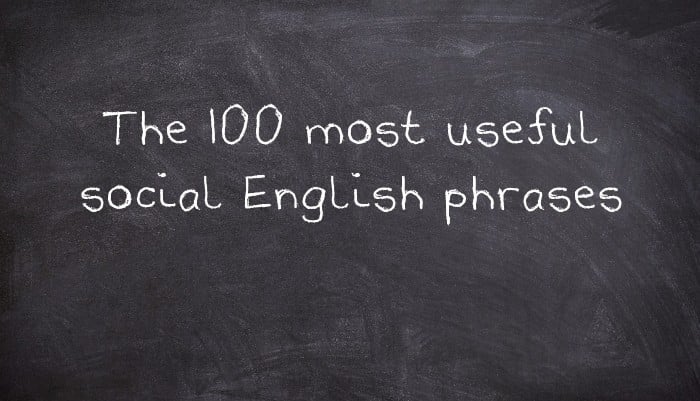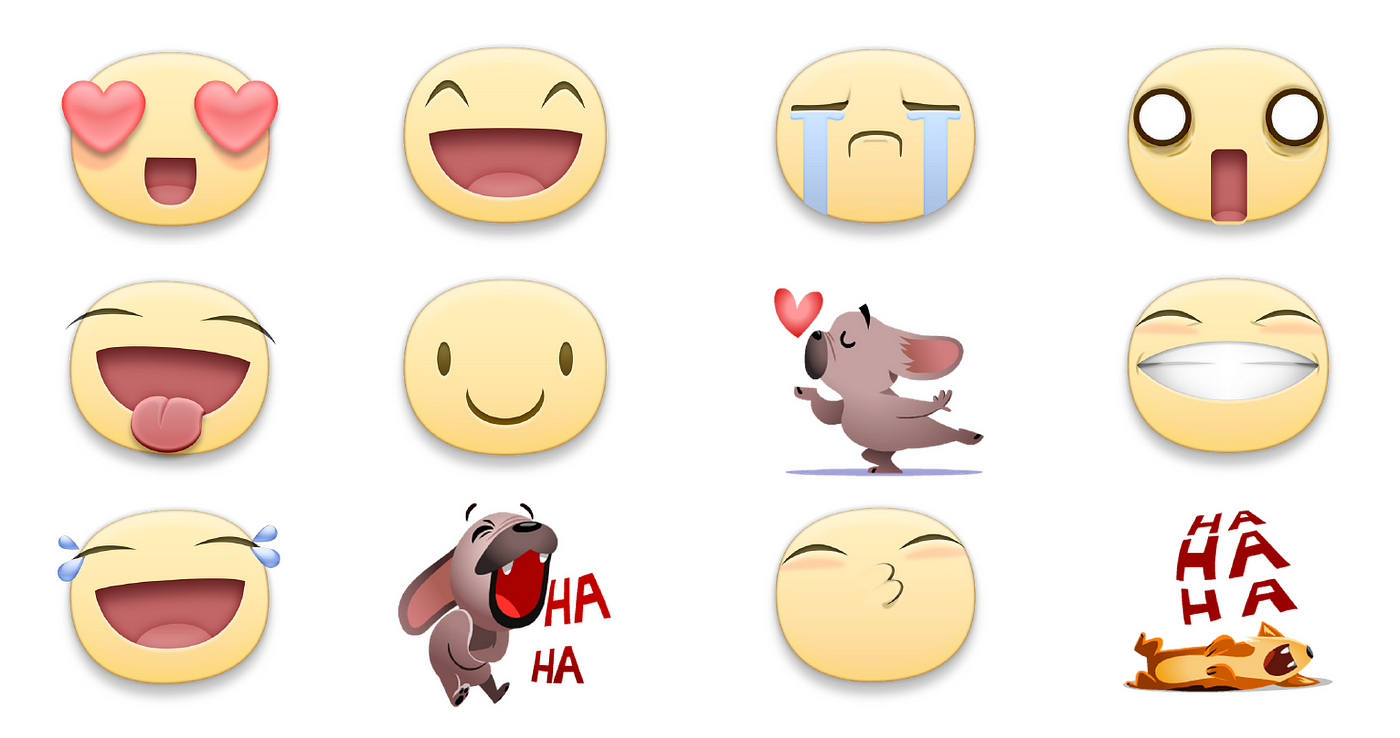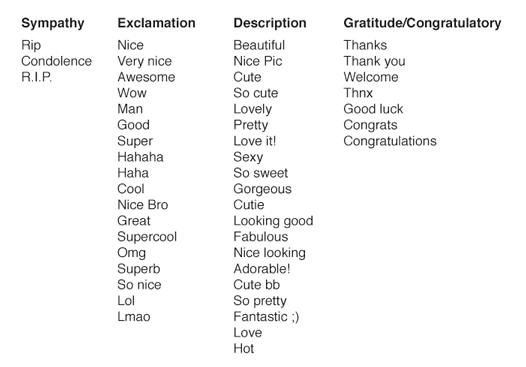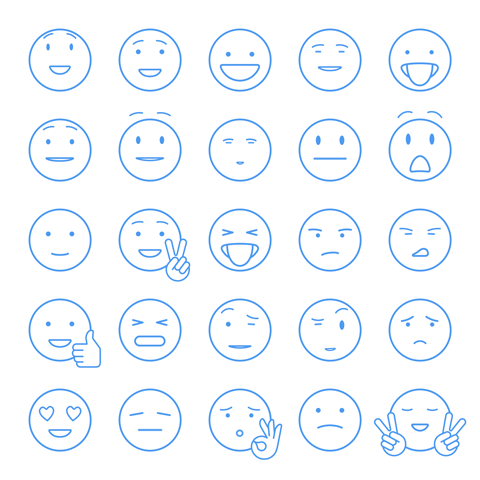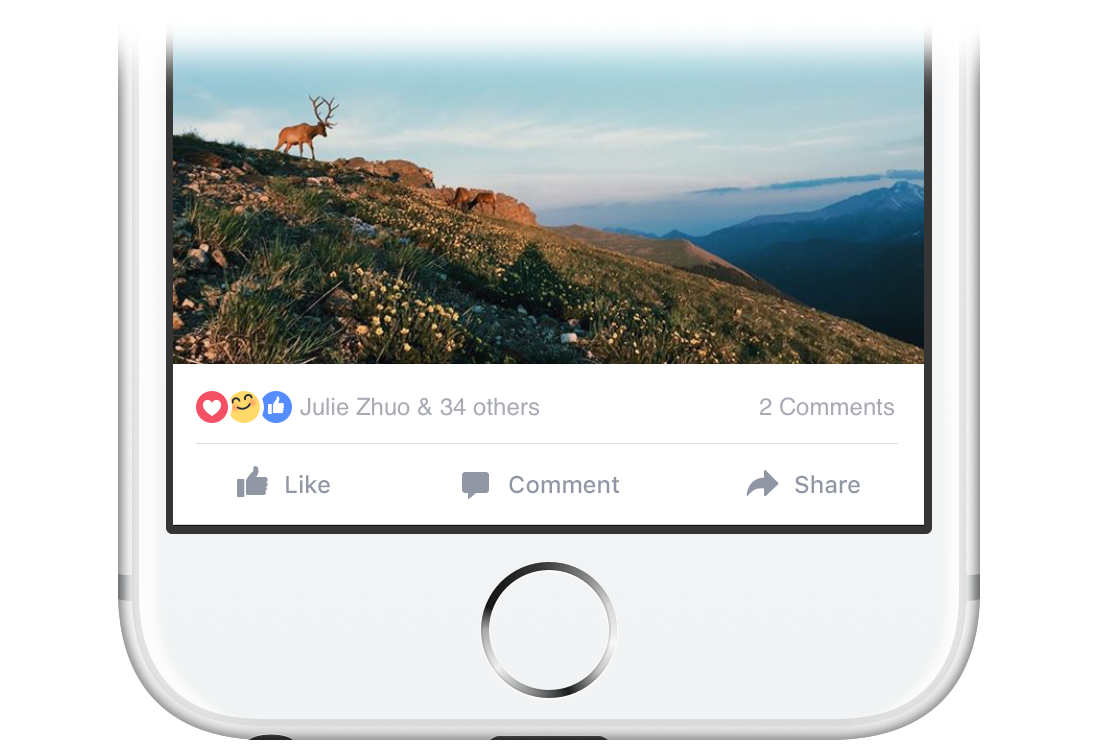Reacting to what people say
Reacting to what people say
The 100 most useful social English phrases
Summary: The most important social English phrases for meeting and greeting, dealing with small talk, making guests feel comfortable, etc.
By: Alex Case | Category: Learning English | Topic: Discourse
This is a list of the most vital phrases for starting conversations, meeting people, sustaining and responding to chitchat, etc. For invitations, recommendations, dining out together, etc, see “The 100 most useful socialising phrases”. For intensive practice of these phrases and a bigger list of useful phrases, see Teaching Social English: Interactive Classroom Activities at https://www.usingenglish.com/e-books/social-english/
Meeting people/ Starting and ending conversations
Starting the conversation
(Excuse me.) Is anyone sitting here?/ Is this seat free?
(Sorry) do you speak English?
(Sorry,) is this the right place/ the right room for…?
Good morning/ afternoon/ evening. I’m here to see/ meet John Smith. (I’m guessing that’s you.)
Talking about names
(Sorry, I forgot to introduce myself./ I should probably introduce myself.) My name is Alexander Case (but please call me Alex/ but everyone calls me Alex).
(Are you) John?/ You must be John.
(Yes.) That’s right./ That’s me. (And you must be…/ And you are?)
I’m sorry, I didn’t catch your name.
Polite language the first time you meet (after giving names)/ Expressions meaning “Nice to meet you”
(It’s) (really/ very/ so) nice to meet you (too).
(I’m) (very) glad/ pleased to meet you (too).
(We’ve emailed each other but/ We’ve spoken many times on the phone but) it’s so nice to finally meet you (face to face).
Expressions meaning “Nice to see you (again)”
(It’s) lovely/ great/ so nice to see you (again) (too).
Meeting again after a long time
(I don’t know if you remember me, but) we met…/ we worked together…/ we…
(Wow!) Long time no see. How have you been (since we last met)?
Other polite and friendly language at the beginning of a conversation
I’ve been looking forward to meeting you (too)./ I’ve heard so much about you (too).
Welcome (back) to…
Thanks for coming all this way/ coming such a long way (on such a cold day/ hot day/ humid day/ snowy day/… day).
Thanks for inviting me/ us (to…).
Ending small talk/ Ending conversations
Transitions language then saying something nice about the conversation
Well, it’s been great to talk (but…)
So, it’s been lovely to catch up (but…)
Okay then, I’d love to chat more/ hear more about that (later) (but…)
Giving a reason for ending the small talk/ ending the conversation
I’m afraid/ Unfortunately/ I’m sorry but I have a(nother) meeting at… (o’clock) (so…)
I know you are very busy (so…)
We have a lot to get through today (so…)
We only have this room until twelve (so…)
Getting down to business
Do you have a minute to talk?/ Are you free to talk?
(As you know/ As I said in my email) I (just) need to talk to you about…
Reacting when the other person needs to end the conversation
(Of course) I’ll let you get on (then)./ (Sorry) I won’t keep you any longer (then).
Moving to another place/ Directing people/ Giving directions/ Leading people somewhere
This way please./ After you./ Please follow me.
Introducing other people
Have you met…?/ I don’t think you’ve met.
I’d like to introduce you to/ Can I introduce you to (my colleague/ my boss)…?
This is (my/ the…) John (Smith).
Phrases like “Nice to meet you” at the end of the conversation
It was (really/ very/ so) nice to meet you.
(It was) nice/ great meeting you.
Like “Nice to see you (again)”, but at the end of the conversation
It was lovely/ great/ so nice to see you (again).
Small talk at the end of a conversation
Are you finished/ Have you finished (for the day/ for the day/ for the week)?
Do you have (m)any more meetings (today)?
Do you have to go (straight) back to your office (now/ after this)?
Do you have any plans for this evening/ for the weekend/ for…?
Good wishes for something that the other person will do in the future
(I hope you/ Hope you) have a good time/ good weekend/ good evening/ good time/ good trip.
Take care./ Bon voyage./ Have a safe journey (back/ home).
Good wishes for other people
(Please) pass on my (best) regards to…/ say “Hi” to… (from me).
Mentioning future contact
(I) hope we have the chance to meet again (soon).
(I) look forward to seeing you/ hearing from you/ your call.
Other friendly and polite language at the end of a conversation
Thanks again for taking the time to come here today.
I hope you had a good time/ I hope it was worth the trip/ I hope…
Thanks, that was really useful/ lovely/ really productive/ very stimulating/ a real eye opener/…
Small talk
Small talk when meeting for the first time
Is this your first time here/ in…/ here in…?
What do you do (for a living)?
What does your company/ division/ department/ section/ team/… do?
Where is your company based?/ Where are you based?/ Where do you work?/ Do you work near here?/ Is your office near here?/ Are you based near here?
Who do you work for? (What do you do there?)
Small talk with people you’ve met before
What a coincidence!/ This is a nice surprise. (I didn’t know that you were interested in…/ that you were in the area/ that you…)
Did you have a good/ nice/ fun weekend/ evening/ holiday?
(Have you) been busy (lately/ recently/ today/ this week)?
How has your day been/ week been (so far)?
How was your (long/ three-day) weekend?
How was your (summer/ Xmas/ New Year/ Easter/ bank) holiday/ vacation?
How’s it going?/ How are things?/ How are you doing?/ How’s life (treating you)?
How’s John (doing/ getting on/ getting on with…)?
How’s your project going?/ How’s… going?
What are you working (on at the moment)?/ Are you (still) working on…?
Small talk when meeting for the first time or again
Did you have any problems getting here?/ Did you have any trouble finding us?
How long are you here?/ How long will you be here?/ How long are you staying (in…) (this time)?/ Are you staying long?
How was your flight (from…/ to…)?/ How was your journey (here/ from…)?
How’s the weather (outside/ outside now/ in…/ back in…) (now)?/ Is it still…?
It’s (a bit/ rather/ quite/ really/ so) humid/ cold/ hot/ grey/ crowded/ busy/…, isn’t it? (Is it usually like this (at this time of year))?
Was the map (that I sent) okay?
What brings you here (today)?/ What brings you to…?/ Are you here for/ to…?
(You must be really jet lagged). What time is it now in…?/ What’s the time difference between… and…?
Answers to “How…?” questions
(Really) great/ (Pretty) good/ Very well/ Not (so/ too) bad/ Fine
Not so good/ Not so great.
Talking about your studies or company and job
I’m studying (for)… at…
I work for ABC Limited./ I work in the… department/ division/ section of ABC Limited.
I’m in charge of/ I’m responsible for…
Not answering questions (politely)
I’d rather not say (if you don’t mind).
Asking the same question back to someone
How about you?/ And you?/ What about you?
Reacting to what people say
Positive reactions (reacting to good news, etc)
I’m happy/ relieved/ delighted to hear that.
That sounds great/ lovely/ delicious/ nice/ fantastic/ wonderful/ fabulous/ perfect/ ideal.
Negative reactions (reacting to bad news, etc)
I’m sorry to hear that.
That’s a pity./ That’s a shame./ That’s too bad.
That sounds awful/ terrible/ unbearable/ stressful/ like a nightmare.
Active listening
Encouraging someone to continue
Showing you’re listening/ Not listening in silence
Changing topic
(Talking of…,) that reminds me,…
Offers
Offering/ Helping (making a guest comfortable, etc)
(Would you like) something to drink/ tea or coffee?
Can I take your bag(s)/ your coat(s)/ your…?
Please take a seat (anywhere you like) (and she’ll come out and see you shortly).
(Please) make yourself at home. (You can leave your coat/ bag/ stuff/… here/ over there/… if you like).
Please help yourself (to sugar/ to…)
Responding to offers
That would be great/ lovely/ a great help/… (but…)
Thank you, that’s very kind (but if you don’t mind, I’d prefer…)
Discussing business cards
Do you have a business card (on you)?
It’s (all) written on my business card. (Let me give you one). Here you are./ Here you go.
Thanks. And here’s mine.
(Oh,) I see (from your card) that you…
Copyright © 2019 Alex Case
Reactions: Not everything in life is Likable
I come to Facebook to share all kinds of things with people I care about — from celebratory posts about practicing yoga for 60 days straight, to mourning the loss of a parent. Those same people who connect with me on my stories also have their own stories to share. Sometimes we just want a simple way to say we really love what they shared, or to express empathy when life takes a turn.
In 2009, Facebook introduced a button that allowed people to give feedback to their friends’ posts. We called it Like, and people liked it a lot. It’s simple and effortless to scroll down your News Feed and tap the little thumb to acknowledge what your friend posted. Sometimes it can be tough to know what to say; or maybe you don’t really have much to say and you just want to let someone know you heard them. That’s what the Like button does so well. It is simple and frictionless.
But, not everything in life is Likable.
It was time to look beyond the Like.
People had told us that they’d like more ways to express themselves on Facebook. About a year ago, Mark brought together a team of people to start thinking seriously about how to make the Like button more expressive. We were excited to start this process — It’s not every day you get the chance to work on such an important piece of a company’s product.
We knew at the onset that this project would be challenging. There were obvious challenges like making the solution work on various platforms and across a host of devices, both old and new. Then there were more challenging aspects to figure out. For instance, we have spent a lot of time refining the Like, Comment, Share buttons so that it’s easy to use and understand. It is a surface that is interacted with a lot, so any change will affect the understandability and usability of millions of people’s actions. We needed to thoughtfully curate any change so it felt like a natural evolution, taking care not to feel abrupt or disrupt everyone on our platform.
There were other questions that would need to be answered: What would the reactions be? How will people understand them globally? How can people best consume Reactions? How can people easily leave a Reaction? These are complex questions to be solved, all while keeping the mechanics of Liking easy.
Like all good design, the process of getting to a simple solution is complex.
It was incredibly important to be empathetic here and it’s why we did so many iterations, and took the amount of time we did. The whole point of expanding reactions is to have a universally understood vocabulary with which anyone can better and more richly express themselves.
We broke the problem down into two distinct pieces and began to work them in parallel:
For both of these tracks, we came up with key principles that we’d use as a playbook by which we operated. These principles acted as a guide for our team and helped us clarify decisions throughout the life of the project. They wouldn’t explicitly tell us what the final solution was, but they would hint at what it wasn’t and provide a direction for us all to head in.
Principles, combined with insights from empirical research and data, along side the instincts and knowledge gleaned from the talented industry elites here at Facebook was how we’d solve this. As such, the team we created included researchers, content strategists, engineers, and my main design team: Andy Chung, Brandon Walkin and Brian Frick.
The Reactions
Here are the principles that guided us in determining the set of reactions we are rolling out with now:
We first needed to consider how many different reactions we should include. This might seem like a pretty straightforward task: Just slap a thumbs down next to the Like button and ship it. It’s not nearly that simple though. People need a much higher degree of sophistication and richness in what choices we provide for their communications. Binary ‘like’ and ‘dislike’ doesn’t properly reflect how we react to the vast array of things we encounter in our real lives.
Even though this wasn’t going to be binary, was this going to be like emoji, where people have hundreds to choose from? Probably not. Amongst other reasons, having hundreds of reactions to choose from could mean each post had dozens of different types of reactions left on it, which would be difficult to consume in News Feed. Additionally, the more reactions we offered, the less likely they would all be universally understood.
For more than a year, we have been conducting international research to explore what types of reactions people might find most appealing. Here are some of the things we looked into:
Top Stickers
We looked in aggregate at top stickers and emojis to get signal on what types of “reactions” people were already using on Facebook.
Most Used Search Terms for Stickers
While less common, we also looked at what terms people searched for when using stickers:
Top short comments
We also took an anonymized global sample of commonly used, short comments. These gave us some of the specific language that people use to express themselves, and helped us understand more fully the context in which people use these types of comments. Here’s an example of some short comments we saw from the U.S.
In addition to analyzing samples, we did international surveys, talked to people, and worked with our internationalization team. From here, we narrowed the set down to a more refined list:
You may have noticed that there are two reactions from that list that aren’t in what we released in this week’s launch: “Confused” and “Yay”. In testing, “Confused” was used so rarely that it didn’t make sense to include it given the cognitive load adding additional reactions has. Each reaction needs to serve a unique purpose for most people, and “Confused” didn’t end up doing that. “Yay” was tough to justify too. It wasn’t as easy to understand or internationalize, and it would often overlap with “Haha” or even “Like”. The system was just better as a whole without these two for now.
The Illustrations
Another crucial component was what reactions should look like. We wanted to create illustrations that were unique to Facebook, but we also wanted them to live gracefully in the ecosystem, and be easily and universally understood. Here was an initial direction:
Our initial illustrations weren’t communicating what they were intended to communicate to when they were seen at a relatively small size. They had served their purpose as placeholders as we designed the system, but it was time to start iterating on these.
The challenges here included figuring out what style would be appropriate to encompass across the set, and still have each individually and clearly express the intended reaction. Overlapping how we expressed the reactions was also something we encountered. The tiniest design tweak to one reaction could make it look too similar to another, or even end up not expressing the reaction at all. “Wow” could start to bump into “Yay” and “Yay” could look like “Haha” just by changing the curve of a smile or the squint of an eye.
We also explored a system both with, and without, labels. Labelling the reactions helped define what the reactions were, and that in turn, helped with internationalization. These needed to be universally understood, so if a friend from Japan reacted to your post, you mutually agree upon what that reaction meant. To understand this, we worked closely with internationalization teams and professionals in the field of non-verbal communication. We ran various research studies and tested early versions in different countries.
Early versions were static and we knew animation would be key in making them more expressive. We worked with an animator to bring the static reactions to life, while designers and engineers figured out how to make these play in a performant manner. Designers used pseudo-code to programmatically animate each reaction. Their work could then be passed on to Engineers to replicate the intended animation with high precision in the final build so they animate buttery-smooth.
When we started incorporating animations, we thought simultaneous animations would be overwhelming to the eye. So at first, we had only one reaction animating at a time (the one your finger was scrubbing over), while the rest of them remained static. While not intended to work this way, we realized during a Zuck review (where you meet with Mark to show progress of a big project like Reactions) that if you quickly scrubbed your finger across all of them they would all animate at once. Mark himself suggested we animate all of them concurrently when the dock is exposed. It turns out we liked this a lot more too. Thanks, Zuck.
The System
Without some predetermined context of principles within which we agreed to operate, we could quickly find ourselves building a complicated system that wouldn’t scale as well as we needed it to. Here are a few principles that guided us:
Leaving a reaction
When we started exploring the input mechanism we didn’t know what, or how many, reactions there would be. Some early research said it would probably be somewhere between five and ten. As a stress test, we started by designing an input that could house up to fifteen different reactions, since it would be easier to scale it back than it would be to extend it.
Early concepts and initial attempts like these are purely educational — they teach us what works, but often more importantly, what doesn’t. They reveal gaps, unknowns, and more.
While we felt the above approach did a decent job of allowing a broad range of feedback quickly, it revealed some problems. In other words, it was teaching us about what the solution would need to encompass:
We continued to iterate. The first prototypes included a single illustration that would change based your finger’s position over the expression word. This evoked a desire to preview each reaction before making your decision, instead of just being able to see all options at once. It was too cumbersome and time consuming.
Eventually, we dismissed the single illustration concept in favor of the dock model. This approach allowed people to quickly see all of the reactions at once. Parsing facial expressions instead of reading text created a much friendlier and internationally recognizable system. We were able to solve other problems that earlier concepts had as well. For example, this new system adapted to its position on screen, so no longer would it be positioned out of view. We moved the labels of the reactions so your finger never obscured them. Lastly, once the reactions dock was invoked, people could now either scrub or tap on the reactions to choose one.
Consuming Reactions
In a world where we only had to deal with Likes, how you consumed them was pretty straightforward. We just told you how many it had by saying “17 Likes.” It’s a string of text that sits right above the Like, Comment and Share buttons. That string of text is internally called the Bling String. This would need a complete rethink because stating “10 Reactions” didn’t communicate any of the variable sentiments that this feature was designed to provide — Did people generally find this post funny, sad or surprising? The solution needed to let the specific reactions be individually recorded. We also wanted to continue to be able to convey total feedback, just as we did with a total Like count.
Our first approach was an obvious one. We would design the bling string to show each reaction used and include a count of how many times it had been left. This worked fairly well on posts that had just a couple reaction types left on it, but it really fell apart on those that had a ton of engagement — especially public content. It also was difficult to understand the total feedback. The old bling string was simple because it was only conveying one piece of information. As a result, it was easy to scan and understand, or ignore and scroll.
The final solution was to aggregate the top three reactions coupled with a total count. This way, you could understand how the majority of people reacted to a post, as well as understand the total feedback on a post. In addition, we also communicated which of your closest friends reacted to the post, something that was absent on mobile until the introduction of Reactions. You can see all the various reactions people have left by tapping on the bling string from an individual post.
The “final” product
After nearly a year of work and months of testing, we’re really excited to be launching Reactions and learning more about how it’s used around the world. We’re hopeful everyone likes Reactions now that we’re rolling it out more broadly.
As with all software design, nothing is ever done, final, or finished—and Reactions is no exception. We’ll be continuing to learn, iterate and improve upon it, but we’re hopeful this is a step towards a more empathetic Facebook experience.
Sam Fischer Demi Lovato What Other People Say Official Video
03:31 4.63 MB 19.1M
Taylor Swift Shake It Off
04:02 5.31 MB 3.2B
Upfront What People Say Ft Res
04:29 5.90 MB 1.1M
Demi Lovato Sam Fischer What Other People Say Lyrics
03:15 4.28 MB 865.7K
Sam Fischer Demi Lovato What Other People Say Official Audio
03:16 4.30 MB 790.3K
Don Diablo People Say Ft Paije Official Music Video
03:09 4.15 MB 16.6M
Beres Hammond They Gonna Talk
03:59 5.24 MB 11.6M
Dennis Vs Ulrikke What Other People Say Sam Fischer Demi Lovato Battles The Voice Norway
02:28 3.25 MB 95.7K
Sam Fischer Demi Lovato What Other People Say Lyrics
03:48 5.00 MB 203.9K
Sam Fischer Demi Lovato What Other People Say Clean Lyrics
03:16 4.30 MB 234K
Sam Fischer Demi Lovato What Other People Say Stripped Version Official Video
03:27 4.54 MB 1.4M
Sam Fischer Demi Lovato What Other People Say Lyrics
03:16 4.30 MB 222.2K
S C A R R What People Say Visualizer
03:09 4.15 MB 90.8K
Sam Fischer Demi Lovato What Other People Say Lyric Video
03:16 4.30 MB 3.1M
Sam Fisher Demi Lovato What Other People Say Official Video Sub Español Lyrics
03:54 5.13 MB 158.6K
Wu Tang Clan People Say Ft Redman Official Music Video
04:45 6.25 MB 19.7M
Demi Lovato Sam Fischer Perform What Other People Say
03:28 4.56 MB 875.7K
What Other People Say
03:15 4.28 MB 183K
Sam Fischer Demi Lovato What Other People Say Lyrics 1 Hour
01:58 80.24 MB 15.6K
Cover Mette Marie Max Atzmon What Other People Say Demi Lovato Sam Fischer
03:01 3.97 MB 66.4K
Sam Fischer What Other People Say Original Demo Official Video
03:33 4.67 MB 75.7K
Sam Fischer Emma Heesters What Other People Say
03:23 4.45 MB 187.7K
English File Intermediate 4th Practical English Reacting To What People Say SUBTITLES
02:15 2.96 MB 5.9K
Portugal The Man People Say Official Music Video
03:22 4.43 MB 5.8M
What Will People Say Trailer 1 2018 Movieclips Indie
02:11 2.87 MB 4.2M
Sam Fischer Demi Lovato What Other People Say EASY Piano Tutorial
What Do People Say Behind Your Back Pick A Card
01:44 79.93 MB 2.5K
Sam Fisher Feat Demi Lovato What Other People Say
01:02 1.36 MB 1.3K
Demi Lovato What Other People Say Solo Version
03:20 4.39 MB 51K
Lady Antebellum Things People Say Music Video
04:56 6.49 MB 5.1M
Chinedu Nwadike You Are More Than What People Say Igbo
08:44 11.49 MB 132.4K
Reddit People Say It S Waste Of Time To Memorize NBMEs Is That True
05:17 6.95 MB 729
Whatever People Say You Are Black
03:59 5.24 MB 89.3K
Lady Antebellum Things People Say
03:49 5.02 MB 448.3K
What Did PTI People Say About Shahbaz Gill To Hamid Mir Capital Talk Hamid Mir Geo News
07:01 9.23 MB 49.3K
Sam Fischer Demi Lovato What Other People Say Acoustic Karaoke
03:20 4.39 MB 5.7K
Portugal The Man People Say Acoustic
03:21 4.41 MB 199.6K
What People Say When They Don T Know What To Say Adrianne Haslet Davis TEDxBeaconStreet
15:23 20.25 MB 2.6M
People Say That I M Over The Top
02:58 3.90 MB 168.1K
What Do People Say About Me Part 3 Subtitles English BK Shivani
16:48 22.11 MB 175K
The Revivalists Some People Say
04:11 5.51 MB 213.7K
Luke Davidson Dumb Things People Say Tik Tok Compilation TikTok Craft
08:25 11.08 MB 82.5K
Worried What Will People Say Part 7 BK Shivani English
12:08 15.97 MB 106.1K
I DONT CARE WHAT PEOPLE SAY ABOUT ME
16 359.38 KB 1.3K
What People Say About You When You Leave The Room PICK A CARD READING
41:21 54.42 MB 2.3K
What Will People Say Omar Suleiman
02:11 2.87 MB 7.7K
What Other People Say Michael Dameski Choreography
01:28 1.93 MB 78.5K
Rusun Pengabdi Setan 2 Angker People Say
06:21 8.36 MB 1.1K
Why People Say Nick And Priyanka S Love Is FAKE
05:14 6.89 MB 201.4K
Sh T People Say To Bartenders
05:35 7.35 MB 3.1M
Для вашего поискового запроса What The People Say мы нашли 50 песен, соответствующие вашему запросу. Теперь мы рекомендуем загрузить первый результат Sam Fischer Demi Lovato What Other People Say Official Video который загружен SamFischerVEVO размером 4.63 MB, длительностью 3 мин и 31 сек и битрейтом 192 Kbps.
Слушают сейчас
What The People Say
Половина Моя Кавказский Cover
Incoming Mc Orsen
Мухаммадзиё Концерт 2022
Минимал Элджей Ремикс
Ты Просто Знай Перевернётся Мир Вокруг
Crymewave Verdugo Remix
Скайть Музыку Этой Ночью Я Умру Если Не Съем Шаурму
Азери Бас Мусик Калонка
How To Uninstall Sql Server 2005
Доля Доля Cover
Песни Про Войну На Донбассе
Помни Обо Мне Романс Ноты И Видеоурок Для Фортепиано Piano Cover
Я Пешком Постою
Дал Декъал Йойла Хьо Мадина
Бемори Гаму Дард
Речку Я Переплыву Быструю Игривую Скачать Песню
Алака Мувет Мувет
Otamni Asragin Ollohim
Turk Muzik Gudok Uchun
Парень Транс Угарные Приколы
Qayda Qoldi Onam Aytgan Chiroyli Qizlar Europa Uz
Nini Badurashvili Da Bichola Mitxar Sad Gedzebo Saqeifo Profili
New Trek Sayod Беномусо 2 Репе Ки Хама Ждат Дошт Топ 2021
У Природы Нет Плохой Погоды Служебный Роман Wmv
Free Scp 3008 Friday Remix
Танцуй Если Знаешь Этот Тренд Тренды Из Тиктока Tiktok Trend
Спасибо Я Пешком Постою
Дагестанский Ватсап Чат 2019 Новинка Приколы Dagestan Whatsapp Chat 2019 Novelty Fun
Best New Eurodance Djeff Z Feelings New Italo Disco
Doddy Feat Lora Dor Sa Te Ador Dj X Kz Dance Remix Hd
Marina Bubblegum Bitch Lyrics Oh Dear Diary I Met A Boy He Made My Doll Heart Light Up With Joy
Айгуль Габдуллина Эй Каеннар 2019
Внеорбитные Speed Up
Pathetic Dreamcore Sped Up Tik Tok Version
Pam Pam Pam Original Meme
Jasurbek Mirzajonov Sevgimni Sotganlar Audio 2022
